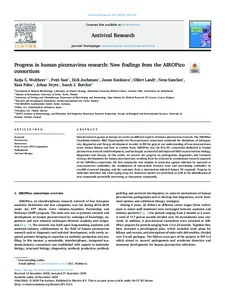| dc.contributor.author | Wolthers K | |
| dc.contributor.author | Koskinen J | |
| dc.contributor.author | Landt O | |
| dc.contributor.author | | |
| dc.contributor.author | Sanchez N | |
| dc.contributor.author | Palm K | |
| dc.contributor.author | Susi P | |
| dc.contributor.author | Butcher SJ | |
| dc.contributor.author | Neyts J | |
| dc.contributor.author | Jochmans D | |
| dc.date.accessioned | 2022-10-28T14:08:55Z | |
| dc.date.available | 2022-10-28T14:08:55Z | |
| dc.identifier.uri | https://www.utupub.fi/handle/10024/169646 | |
| dc.description.abstract | <p>Several research groups in Europe are active on different aspects of human picornavirus research. The AIROPico
(Academia-Industry R&D Opportunities for Picornaviruses) consortium combined the disciplines of pathogenesis, diagnostics and therapy development in order to fill the gaps in our understanding of how picornaviruses
cause human disease and how to combat them. AIROPico was the first EU consortium dedicated to human
picornavirus research and development, and has largely accelerated and improved R&D on picornavirus biology,
diagnostics and therapy. In this article, we present the progress on pathogenesis, diagnostics and treatment
strategy developments for human picornaviruses resulting from the structured, translational research approach
of the AIROPico consortium. We here summarize new insights in protection against infection by maternal or
cross-protective antibodies, the visualisation of interactions between virus and neutralizing antibodies by
cryoEM structural imaging, and the outcomes from a picornavirus-infected human 3D organoid. Progress in
molecular detection and a fast typing assay for rhinovirus species are presented, as well as the identification of
new compounds potentially interesting as therapeutic compounds.<br /></p> | |
| dc.language.iso | en | |
| dc.title | Progress in human picornavirus research: New findings from the AIROPico consortium | |
| dc.identifier.urn | URN:NBN:fi-fe2021042720335 | |
| dc.relation.volume | 161 | |
| dc.contributor.organization | fi=biolääketieteen laitos, yhteiset|en=Institute of Biomedicine| | |
| dc.contributor.organization-code | 2607100 | |
| dc.converis.publication-id | 37021873 | |
| dc.converis.url | https://research.utu.fi/converis/portal/Publication/37021873 | |
| dc.format.pagerange | 100 | |
| dc.format.pagerange | 107 | |
| dc.identifier.jour-issn | 0166-3542 | |
| dc.okm.affiliatedauthor | Susi, Petri | |
| dc.okm.discipline | 1182 Biokemia, solu- ja molekyylibiologia | fi_FI |
| dc.okm.discipline | 1183 Plant biology, microbiology, virology | en_GB |
| dc.okm.discipline | 1182 Biochemistry, cell and molecular biology | en_GB |
| dc.okm.discipline | 1183 Kasvibiologia, mikrobiologia, virologia | fi_FI |
| dc.okm.internationalcopublication | international co-publication | |
| dc.okm.internationality | International publication | |
| dc.okm.type | Journal article | |
| dc.relation.doi | 10.1016/j.antiviral.2018.11.010 | |
| dc.relation.ispartofjournal | Antiviral Research | |
| dc.year.issued | 2019 | |
